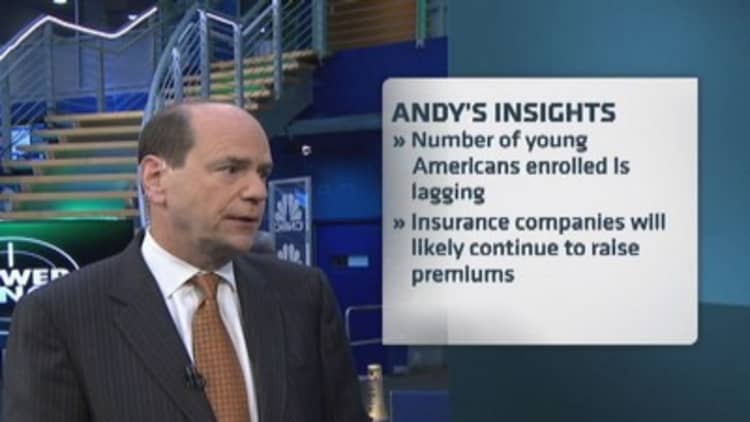At least 3 million more people were enrolled in Medicaid or children's insurance programs by the end of February than before the beginning of Obamcare sign-ups, federal officials said Friday.
That post-Obamacare number is expected to grow, possibly significantly, because February's data is not complete, and because it does not now reflect a huge influx of visitors to government-run Affordable Care Act exchanges in March.
Those exchanges enroll people in private insurance, and determine whether applicants are eligible for the government-run Medicaid and CHIP programs, which give health coverage to poor adults and children, at no cost to enrollees.
In 46 states reporting both pre- and post-Obamacare data, enrollment in Medicaid and CHIP before October grew from about 58 million to 61 million, according to the Centers for Medicare and Medicaid Services.
Read MoreUninsured Americans dropped by 5.4 million
"It is important to note that enrollment numbers reported today are underestimates of what the actual enrollment in February will ultimately be," a CMS fact sheet said. That sheet noted that not all states have reported enrollment data, and "the data are preliminary and do not include most individuals who will later be found eligible for Medicaid effective in February."
"We expect enrollment in March to be even higher, although individuals can continue to enroll in Medicaid year round," said Health and Human Services Secretary Kathleen Sebelius.
In light of the end-of-month deadline for 2014 enrollment, March saw a surge of visitors to the Obamacare exchanges. Nearly 3 million people—at the least—gained coverage in private insurance sold on the exchanges that month, and an unknown number were determined eligible for Medicaid and CHIP.
Read MoreInsurance a tough sell for young? Blame mom and dad
Many of those people were motivated by the desire to avoid paying a tax penalty next year for failing to obtain health coverage bylast Monday's deadline. The ACA mandates that nearly all Americans have some form of coverage this year.
Friday's data showed that enrollment in those programs increased to a greater extent in states than had expanded eligibility for Medicaid to capture more low-income adults than in states that did not.
In so-called expansion states, enrollment in Medicaid and CHIP jumped by 8.3 percent, compared with an increase of just 1.6 percent in nonexpansion states. At total of 26 states and Washington, D.C., have expanded eligibility to allow enrollment for most people under age 65 who earn up to $15,521 annually for individuals and $31,721 for a family of four.
Eligibility determinations by state for Medicaid and CHIP also increased since the launch of Obamacare exchanges, according to data released Friday.
From October through January, 8.9 million people had been determined eligible for Medicaid and CHIP. That tally grew to 11.7 million as of February, according to CMS.
That eligibility data is not comparable to total enrollment data because enrollments include only people eligible for full benefits coverage, while determinations include people receiving all types of coverage, including help paying Medicare premiums.

"The increase in Medicaid enrollments is encouraging, but more work is left to do to ensure that the millions of uninsured Americans eligible for these programs gain coverage," Sebelius said
Sebelius also said that since there's not a deadline for states to expand their eligibility requirements, "we're going to keep working with the remaining states as they decide to come on board."
The White House, in a map showing Medicaid expansion decisions to date, said that 4.3 million people are newly eligible for Medicaid coverage in states that expanded. The White House said nonexpansion states are leaving 5.7 million people without Medicaid coverage they could obtain if their states had decided otherwise.
Because of the way Obamacare subsidies are allocated, and because of the Supreme Court decision that left Medicaid expansion up to individual states, those 5.7 million people also are ineligible to receive tax credits to help them buy private Obamacare insurance from the exchanges.
Sebelius said expansion not only gets health coverage to more people "it's a good deal for the states."
Read MoreHere's the final (we mean it!) Obamacare deadline
She noted that the federal government will pay 100 percent of costs of insuring the newly eligible Medicaid population in the first three years of the program, and 90 percent of related costs after that.
"Expanding coverage reduces hospitals' uncompensated care, lowers 'cost shifting' to businesses that see higher health insurance premiums as some of the costs of caring for the uninsured are passed on to them, and strengthens local economies," she said.
Many Republican governors have opposed Medicaid expansion because they are against Obamacare generally, and because they opposed the ultimate added costs to their states to fund the program partially in future years. Critics have also argued that there is no guarantee that the federal government will not renege on its promise to cover 90 percent of future costs from the expansion-generated enrollees.


